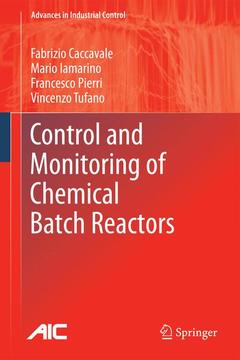Description
Control and Monitoring of Chemical Batch Reactors, 2011
Advances in Industrial Control Series
Authors: Caccavale Fabrizio, Iamarino Mario, Pierri Francesco, Tufano Vincenzo
Language: English
Subject for Control and Monitoring of Chemical Batch Reactors:
Keywords
Chemical Reactors; Control; Fault Diagnosis; Identification; Modelling
Approximative price 158.24 €
In Print (Delivery period: 15 days).
Add to cartPublication date: 11-2014
186 p. · 15.2x22.9 cm · Paperback
158.24 €
In Print (Delivery period: 15 days).
Add to cartPublication date: 12-2010
186 p. · 15.2x22.9 cm · Hardback
Description
/li>Contents
/li>Comment
/li>
The Chemical Batch Reactor is aimed at tackling the above problems from a blending of academic and industrial perspectives. Advanced solutions (i.e., those based on recent research results) to the four fundamental problems of modeling, identification, control and fault diagnosis for batch processes are developed in detail in four distinct chapters. In each chapter, a general overview of foundational concepts is also given, together with a review of recent and classical literature on the various subjects.
To provide a unitary treatment of the different topics and give a firm link to the underlying practical applications, a single case study is developed as the book progresses; a batch process of industrial interest, i.e., the phenol-formaldehyde reaction for the production of phenolic resins, is adopted to test the various techniques developed. In this way, a roadmap of the solutions to fundamental problems, ranging from the early stages of the production process to the complete design of control and diagnosis systems, is provided for both industrial practitioners and academic researchers.
Introduction.- Modeling of Chemical Batch Reactors.- Identification of Kinetic Parameters.- Model-based Control.- Fault Diagnosis.- Conclusions and New Directions.




